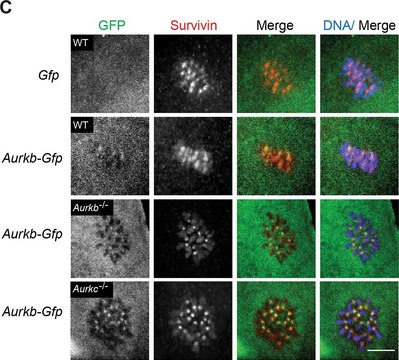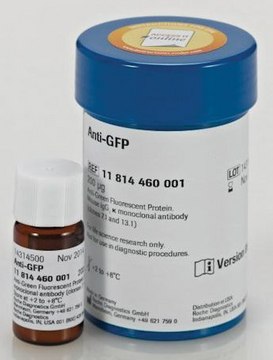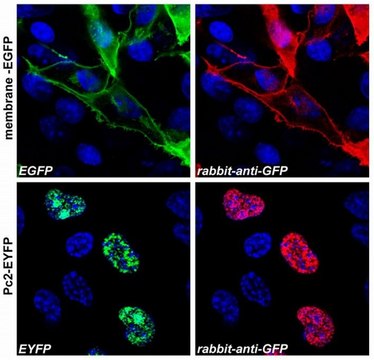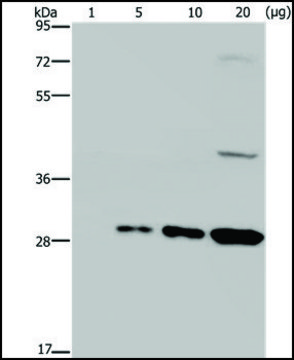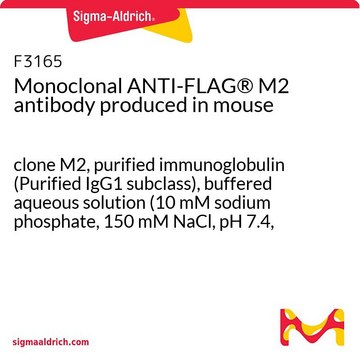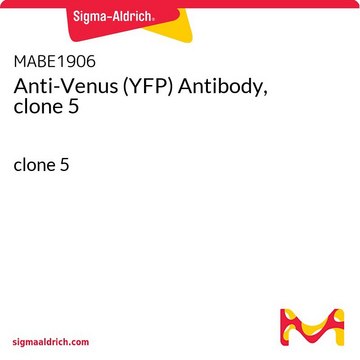MABE1906
Anti-Venus (YFP) Antibody, clone 5
clone 5
Synonym(s):
GFP(YFP), GFP(F46L)
About This Item
Recommended Products
1 of 4
This Item | SAB4200681 | G6539 | SAB2702197 |
|---|---|---|---|
| clone 5, monoclonal | clone GFP-20, monoclonal | clone GFP-20, monoclonal | clone GT859, monoclonal |
| biological source mouse | biological source mouse | biological source mouse | biological source mouse |
| UniProt accession no. | UniProt accession no. - | UniProt accession no. - | UniProt accession no. - |
| technique(s) immunocytochemistry: suitable, western blot: suitable, immunoprecipitation (IP): suitable | technique(s) immunoblotting: 1-2 μg/mL using whole extract of human HEK-293T cells over-expressing GFP tagged fusion protein., immunoprecipitation (IP): 5-10 μg using whole extract of human HEK-293T cells over-expressing GFP tagged fusion protein. | technique(s) dot blot: suitable, indirect ELISA: suitable, western blot: 1:2,000 using purified recombinant GFP preparation | technique(s) ELISA: suitable, immunofluorescence: suitable, immunohistochemistry: suitable, immunoprecipitation (IP): suitable, western blot: 1000-10000 |
| isotype IgG1κ | isotype IgG1 | isotype IgG1 | isotype IgG2b |
General description
Specificity
Immunogen
Application
Western Blotting Analysis: A 1:250 dilution from a representative lot detected Venus (YFP) in HEK293T cells transfected with mVenus that was expressed using pCAGGS-Myc eukaryotic expression plasmid (Courtesy of Li Ten and Kensaku Murano, Ph.D., Keio University School of Medicine, Tokyo Japan).
Immunoprecipitation Analysis: A 1:1,000 dilution from a representative lot immunoprecipitated Venus (YFP) labeled proteins in pCAGGS-myc (negative) and pCAGGS-myc-mVenus (positive) HEK293T cell lysates (Courtesy of Li Ten and Kensaku Murano, Ph.D., Keio University School of Medicine, Tokyo Japan).
Quality
Target description
Physical form
Reconstitution
Storage and Stability
Other Notes
Disclaimer
Storage Class Code
12 - Non Combustible Liquids
WGK
WGK 1
Flash Point(F)
Not applicable
Flash Point(C)
Not applicable
Regulatory Information
Certificates of Analysis (COA)
Search for Certificates of Analysis (COA) by entering the products Lot/Batch Number. Lot and Batch Numbers can be found on a product’s label following the words ‘Lot’ or ‘Batch’.
Already Own This Product?
Find documentation for the products that you have recently purchased in the Document Library.
Our team of scientists has experience in all areas of research including Life Science, Material Science, Chemical Synthesis, Chromatography, Analytical and many others.
Contact Technical Service